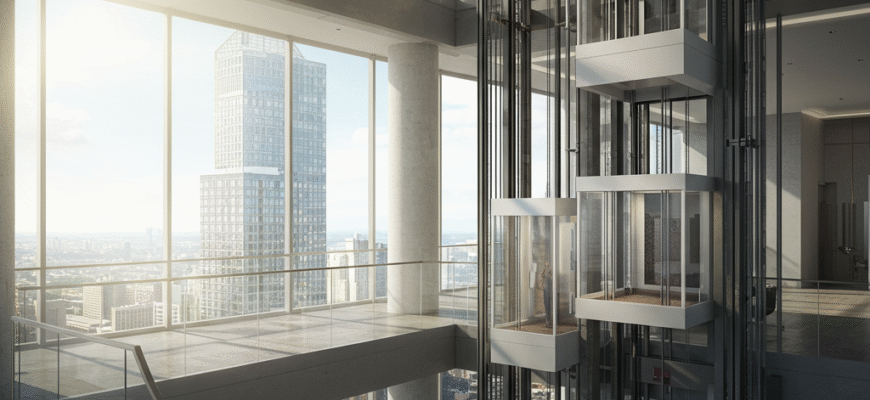Content
The Vertical Barrier and the Safety Breakthrough
The dream of the tall building was effectively grounded by gravity and human endurance. While structural innovations were pushing the boundaries of what could be built, vertical transportation lagged significantly behind. This bottleneck meant that even if a ten or fifteen-story building could be constructed, its upper floors would be largely unusable and unprofitable. A revolution was needed, not just in how buildings were held up, but in how people moved within them. That revolution arrived thanks to the ingenuity and showmanship of Elisha Graves Otis. While others had experimented with lifts, Otis tackled the crucial issue of safety. He developed a reliable safety brake, a mechanism designed to automatically clamp onto the guide rails if the hoisting rope failed. In 1854, at the Exhibition of the Industry of All Nations in New York City’s Crystal Palace, Otis dramatically demonstrated his invention. Standing on a hoisting platform high above the crowd, he ordered the rope cut. Instead of plummeting, the platform instantly locked in place, secured by his safety device. This public demonstration was a turning point, instilling public confidence in the possibility of safe vertical travel.Elisha Otis’s invention of the safety brake in the mid-19th century was pivotal. It transformed the elevator from a dangerous freight hoist into a viable and trustworthy mode of passenger transport. This newfound public confidence directly addressed the primary obstacle preventing the construction and practical use of taller buildings, paving the way for the skyscraper era.
Unlocking the Skies: Elevators and the First Skyscrapers
With the fear of catastrophic failure largely assuaged, the elevator began its ascent into architectural history. The Otis safety elevator didn’t just make taller buildings possible; it made them economically feasible. Architects and developers realized they could now build higher, maximizing the use of expensive urban land. The upper floors, once undesirable, could now be easily accessed. The late 19th century saw the rise of the first “skyscrapers,” particularly in Chicago and New York. Buildings like the Home Insurance Building in Chicago (1885), often considered one of the earliest examples, incorporated iron and steel frame construction, but it was the elevator that allowed occupants to comfortably reach its ten stories. As elevator technology improved, moving from steam to hydraulic and then, crucially, to electric power, the potential for height grew exponentially.The Evolution of Vertical Transport
Electric elevators, introduced in the 1880s, were a significant leap forward. They were faster, smoother, capable of reaching greater heights, and more efficient than their predecessors. This technological advancement coincided perfectly with developments in steel-frame construction.- Speed and Height: Electric motors allowed elevators to travel much faster and serve taller buildings without the limitations of hydraulic systems.
- Efficiency: They required less space for machinery compared to hydraulic systems and were generally more reliable.
- Sophistication: Electric controls paved the way for innovations like push-button operation, automated leveling, and eventually, complex dispatching systems for multiple elevators serving different zones in truly massive buildings.
Reshaping the Urban Landscape
The impact of the elevator extended far beyond simply enabling tall individual buildings. It fundamentally reshaped the entire structure and functioning of cities. Density and Land Use: By allowing buildings to grow vertically instead of horizontally, elevators permitted much higher population and business density on smaller land footprints. This was crucial for the development of concentrated Central Business Districts (CBDs), where commerce, finance, and administration could cluster together efficiently. Real Estate Revolution: The elevator inverted traditional real estate values. Upper floors, previously inconvenient, became premium spaces offering better light, air, and commanding views. Penthouse apartments and top-floor offices became symbols of status and success, a direct consequence of easy vertical access.The elevator’s influence goes beyond mere convenience; it fundamentally altered urban economics and social structures. It facilitated unprecedented urban density, created the modern Central Business District, and completely reversed the desirability hierarchy of building floors. Understanding the elevator is key to understanding the spatial organization of contemporary cities.New Building Typologies: The ability to move people efficiently between many floors facilitated the development of large, multi-functional buildings. Department stores could occupy multiple levels, hotels could offer hundreds of rooms stacked vertically, and the concept of the mixed-use tower—combining retail, office, and residential space—became viable. Accessibility: While initially a catalyst for skyscrapers, the elevator’s influence broadened. It made multi-story hospitals, universities, shopping centers, and apartment buildings accessible to elderly people, individuals with disabilities, and families with young children, democratizing access to vertical space.









